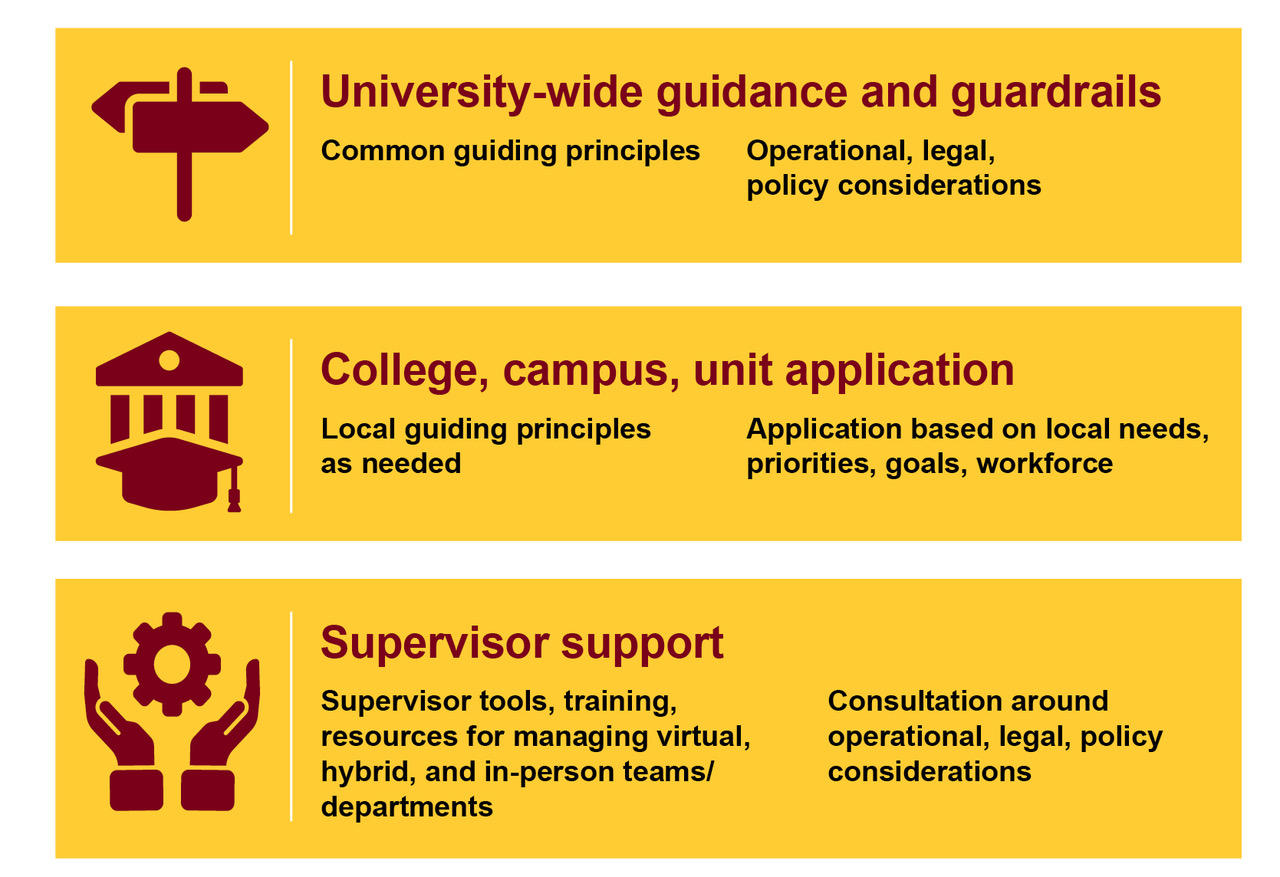College and unit leaders should develop their own flexible work plans in alignment with the University’s system-wide guidance and the following best practices. In addition, they should gather input from supervisors and HR.
Review the best practices below and take a look at how other University colleges and units have developed local Work. With Flexibility. plans based on best practices and system-wide guidance.
Engage faculty, staff, and other stakeholders. Leaders should convene a core team on their campus, college, or unit to determine a hybrid environment model that is driven by the definition of the work that supports the mission, and balanced with the employee perspective and responsive to unique situations.
- Listening to faculty and staff and making their input a part of the process will lead to the best initial model.
- Campus, college, and unit HR should support leadership and supervisors in decision making. HR will provide expertise based on best practices, University policy and procedures, as well as state and federal law.
Evaluate the work. Your unit’s work should drive decisions about where, when, and how the work is performed.
- Prioritize the advancement of our mission as we serve students, faculty and staff, and the community.
- Consider both individual and collective productivity.
- Determine the type of work that can be made flexible as well as the work that must take place on site or at a specific time (e.g., clinical work, custodial work).
- Consider making changes to how work is done. For example, move appointments or meetings that once took place in person be moved to a virtual platform. Adjust or stagger working or office hours to allow flexibility without compromising customer service.
Define flexibility. Flexible work refers to when and where work is conducted. Some units may wish to further expound on flexible work by defining parameters around flex time (working outside of business hours) and flex space (working remotely).
Assess technology and ergonomic needs. Units may wish to outline the technology and office equipment they will provide to employees as part of their Work. With Flexibility. plan (e.g., webcam, monitors, etc). Purchasing and providing equipment for faculty and staff should stay within the parameters of the Purchasing Guidance for equipment outlined by Purchasing Services. Faculty and staff are responsible for costs associated with home internet and phone services.
Ensure equity and inclusion in decision making. All employees, regardless of work location, should have access to the systems, technology, and collaboration methods to carry out their work at any time. This could include VPN technology or specific software in addition to considering ergonomic assessments and assistive technology.
Also, as you make decisions and determine the parameters for flexible work in your unit, check your bias:
- Affinity bias—Giving preferential treatment to someone because they share similar experiences or remind you of someone you know and like.
- Recency bias—Giving recent situations, events, or information more weight and importance than older ones.
- Confirmation bias—Seeking or taking in new information to confirm your own beliefs.
- Consensus bias—Assuming your own thoughts, choices, and judgments are common and shared with others.
Provide ongoing support to supervisors. Supervisors are uniquely positioned to implement flexible work options based on their roles in managing the performance, development, and engagement of their team.
Supervisors should base decisions about flexible work by keeping in mind the Work. With Flexibility. guiding principles and by considering:
- Guidance from senior leaders for their campus, college, or unit and any review of their local work plan that may be required
- The nature of the employee’s work
- University guidance
- Each employee’s perspective and unique circumstances
- Equity, diversity, and inclusion
Communicate with clarity and transparency.
- Flexible work arrangements must be transparent and well communicated. Share the process, principles, and approach used to develop the flexible plan including key dates, early and often, particularly if a large number of employees are currently working from home. This will ensure equity in its application and build trust among faculty and staff.
- Leaders should be clear about which decisions supervisors are empowered to make and when they should consult with their senior leaders and HR.
- Faculty and staff should have a common understanding of expectations for flexible work arrangements in their campus, college, or unit.
- Provide regular updates to faculty and staff, particularly if the plan includes a test or pilot phase.
Define clear goals to manage performance. Employee performance and productivity has never been measured by the number of hours worked. Rather, performance is and should continue to be measured by progress toward clearly defined goals. Managers should prioritize regular one-on-one conversations, explain what success looks like, coach for skills development and provide feedback.
Collect feedback, reassess, and make adjustments. Many campuses, colleges, and units are establishing flexible work practices for the first time, which can create some uncertainty and new complexities.
- This new way of working will require some experimentation and refinement.
- Consider surveys, staff meetings or town halls, or listening sessions to collect feedback throughout the first few months of implementation.
- Give faculty and staff the opportunity to share their perspectives, and provide assurance their feedback will be heard and addressed.
